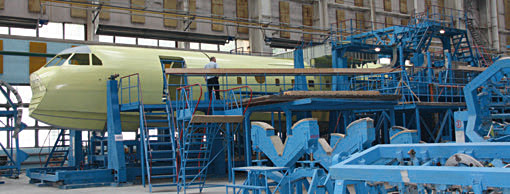|
 A new customer for Russian amphibian Beriev Be-200 has appeared. On 23 May 2013, the Beriev company (a subsidiary of the United Aircraft Corporation) and the Russian Defence Ministry made a government contract for six aircraft of the type for the air arm of the Russian Navy. The amphibians are to be delivered during 2014–16, including two Be-200ChS aircraft and four modified Be-200PS (the latter lacking the fire-fighting capability). The value of the contract totalled 8.4 billion rubles (about $240 million), with the Be-200ChS unit price averaging $43.5 million and that of the Be-200PS – $44.7 million. A new customer for Russian amphibian Beriev Be-200 has appeared. On 23 May 2013, the Beriev company (a subsidiary of the United Aircraft Corporation) and the Russian Defence Ministry made a government contract for six aircraft of the type for the air arm of the Russian Navy. The amphibians are to be delivered during 2014–16, including two Be-200ChS aircraft and four modified Be-200PS (the latter lacking the fire-fighting capability). The value of the contract totalled 8.4 billion rubles (about $240 million), with the Be-200ChS unit price averaging $43.5 million and that of the Be-200PS – $44.7 million.
As is known, the Be-200 amphibian’s baseline model is designed for suppressing forest fires by airdropping water or an extinguisher onto flame bases. It served the basis for the Be-200ChS derivative designed for the Russian Emergencies Ministry that was the launch customer for the plane. The ministry’s air arm has been operating six Be-200ChS amphibians.
Four of them (c/n 101, 102, 201 and 202) were made and delivered to the customer by the Irkutsk Aviation Plant of the Irkut corporation. The fifth production-standard aircraft made in Irkutsk (c/n 203) was delivered to the Azeri Emergencies Ministry in April 2008.
In 2011, the Russian Emergencies Ministry took delivery of two more new Be-200ChS’s c/n 301 and 302 from Beriev this time around. They were assembled and test-flown in Irkutsk during 2010–11 and then modified in Taganrog to meet a more accurate requirements specification issued by the customer.
In March 2011, the government awarded an order for six more Be-200ChS amphibians for the Russian Emergencies Ministry during 2013–15, with the aircraft to be Beriev-built this time. The assembly of the first of the Beriev-made production-standard Be-200ChS planes (c/n 303) is in full swing, and the manufacture of the second aircraft (c/n 304) has commenced. If all goes to plan, the first Be-200ChS to be manufactured by Beriev is to be complete before year-end and commissioned into service by the air branch of the Emergencies Ministry in 2014. Afterwards, Beriev is to deliver the remaining five Be-200ChS in the course of two years.
Under the Defence Ministry-signed government contract published at the official governmental procurement authority website (zakupki.gov.ru), the first Be-200ChS shall be given to the Combat Training and Conversion Centre of the Naval Aviation in Yeisk, Krasnodar Territory before late November 2014. The other aircraft of the type shall be fielded with Knevichi naval air station in the Russian Far East vic. Vladivostok before late November 2015. By the same deadline, Yeisk is to take delivery two Be-200PS SAR/patrol amphibians, while the last two Be-200PS aircraft are due to NAS Knevichi before late November 2016. Beriev expects to land another Defence Ministry order for eight more Be-200s in a few years.
In accordance with the customer-issued requirements specification published at the official governmental procurement authority website, the Defence Ministry-ordered Be-200ChS and Be-200PS amphibians are to have a lifting capacity of 5,000 kg and be able to seat 57 rescuers (troops) or 30 casualties on stretchers. The Be-200ChS fire-fighting version is to be capable of dropping 12 t of water onto the fire on a single run. Its crew may be up to five personnel strong, including the pilot, co-pilot, navigator (inspector), flight engineer and special gear flight engineer.
The flight characteristics of both variants ordered are virtually the same. Their maximal takeoff weight is to account for 41 t when taking off from an airfield and 37.9 t when taking off water (the Be-200ChS will have a maximal weight of 43 t when gliding above water). Their maximal fuel load is to equal 12.5 t, maximal flight speed to stand at 700 km/h (Mach 0.64), service ceiling to be 8,100 m, maximal range on full tanks with the 1-hour fuel reserve to account for 3,150 km and maximal endurance with 1-hour fuel reserve to total 7.5 h. The only significant difference in the performance of the two versions is the 300-kg drop in the weight of the Be-200PS that lacks the fire-fighting gear (28,500 kg compared to the 28,800 kg of the Be-200ChS).
The assigned life of both amphibians is 30,000 h or 12,000 landings, including 8,000 onto land and 4,000 onto water (or 17,450 water scoop cycles, as far as the Be-200ChS is concerned). Their calendar service life amounts to 20 years. The assigned life of their D-436TP engines is 6,000 h or 2,300 cycles.
Beriev is working on wooing new customers all over the world, and an important advantage of the Be-200ChS is that it has been certificated in Russia and the EU. The IAC Aircraft Registry certificated the amphibian as compliant with the AP-25 aviation rules in 2003. In 2007, the Be-200ChS received a supplemental type certificate clearing it for hauling 43 passengers on medium-haul lines and for basing both at airfields and on water. Finally, EASA issued the Be-200ES-E with the European type certificate in September 2010.
In addition to the amphibian’s fire-fighting role, its potential buyers – those in India and Southeast Asian countries in the first place – are interested in its maritime patrol and SAR capabilities. In this field, Beriev’s cooperation with Italian company SELEX Galileo in fitting the Be-200 with its ATOS Airborne Tactical Observation and Surveillance System looks very promising.
|
